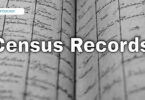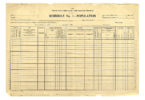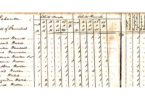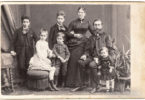The 1790 US federal census was the first one to be conducted in the brand new United States of America. Just seven years off of the end of the Revolutionary War, this census was an ambitious project for its time, but an important one for the fledgling federal government. They needed to know how many people lived within the borders of the new nation, as well as their ages and status as free or slave. The results revealed the population of the new nation (as of Census Day on August 2, 1790) to be just barely under four million people.
The responsibility of taking the 1790 US census was assigned by Congress to the US Marshals in their individual judicial districts. The same act that authorized the taking of the 1790 census governed the taking of all of the US federal censuses (with some minor modifications here and there, including extensions and tweaks) until the 1840 US federal census.
The act of Congress that authorized the census required that the US Marshals and their assistants act as enumerators, and to visit every household in the nation and that the completed census forms be posted in the two most public places in each jurisdiction for enough time to give everyone concerned (meaning the public) time to examine them. The act also mandated that the aggregate amount of each description of a person in the census to be sent to the U.S. President.
This census was begun a little more than a year after George Washington was inaugurated as the first President of the United States, and just before the second session of the new US Congress ended. The 1790 US federal census included only seven questions, which were:
- The name of the head of the household
- The number of free white males in a household of age sixteen and older (this question was to get an idea of the industrial and military potential of the new country)
- The number of free white males in a household under the age of sixteen
- The total number of free white females in a household
- The number of all other free people in a household, of any race or color
- The number of slaves in a household
The Secretary of State at the time this census was enumerated was Thomas Jefferson. He instructed the US Marshals to enumerate all of the original thirteen states, as well as the new districts of Kentucky, Maine, and Vermont, and the Southwest Territory (which later became the state of Tennessee).
When the results of this census came in, both President George Washington and Secretary of State Thomas Jefferson were skeptical of the accuracy of the population results, as they both expected the new United States to have far more people living in it than the 3.9 million people who were recorded. While most historians believe the population count was accurate, those who do allow for the possibility of an undercount believe that if there was one, it was due to poor transportation to a population scattered over thousands of miles, human mistakes in counting, and the refusal of some individuals to participate in the census.
Between 1790 and 1830, the 1790 census results for several states were lost. These were Delaware, Georgia, Virginia, and New Jersey. In addition to these entire states, partial records from the 1790 US federal census were lost from Connecticut, Maine, Maryland, Massachusetts, New Hampshire, New York, North Carolina, Pennsylvania, Rhode Island, South Carolina, and Vermont. However, there are a good number of strong census substitute records that can confirm the lost information recorded in those missing census pages from 1790.
The census information for Vermont, while it was included in the official 1790 census schedules, was not actually taken until 1791. This was because Vermont was an independent country from 1777 until early in 1791 when it was admitted to the union as the first new state. Once it became a state, its census information was enumerated.
The published enumeration of Vermont included sixteen slaves in the state. Other census records until 1860 show Vermont as having seventeen slaves. However, the original census returns for the 1790 and later US federal censuses show that Vermont never had any slaves living in it. The error is attributed to free African-Americans in Vermont being classified as slaves on the censuses. One historian has disputed this claim, while others have accepted this explanation as true.
The 1790 US federal census recorded that almost eighteen percent of the population of the United States overall at the time were slaves. This is the highest percentage of slaves to the free population ever recorded in a US federal census.
Though Maine was part of Massachusetts at the time of the 1790 US federal census, the results for Maine were not recorded with Massachusetts for the census. Instead, they were recorded separately, as if for their own territory. Likewise, the results for Virginia for the 1790 US federal census do not include Kentucky, though Kentucky was part of Virginia at the time. Kentucky results were enumerated separately, as they were for Maine. The part of Virginia that is now West Virginia was, however, enumerated along with the rest of Virginia for this census.
The 1790 US federal census provides a unique snapshot in time of what the United States looked like when it was brand new. It also shows what your American ancestors and their family situations looked like at this exact point in time. Most of the families enumerated in this census would have been around during and before the American Revolution, so this census shows where people went after the Revolution, and what kind of families they built. It also shows the location and family makeup of new immigrants to the new country.
If you are a genealogist doing research into American ancestors with deep roots in the United States, this census is a valuable research resource you don’t want to miss using.




